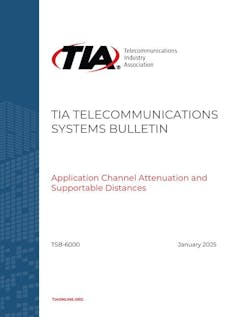TIA Publishes TSB-6000 Detailing Maximum Attenuation and Distances for Cabling Channels

The Telecommunications Industry Association (TIA) recently published Telecommunications Systems Bulletin TSB-6000 Application Channel Attenuation and Supportable Distances. The document was created within the TIA’s TR-42 Telecommunications Cabling Systems Committee and is available for download directly from the TIA.
The tables contained within this TSB define the maximum supportable distance for a number of applications over different media, specifically twisted-pair cabling, broadband coaxial, multimode fiber, and singlemode fiber. In the cases of fiber applications, the tables also include the maximum allowable channel attenuation for applications including Ethernet, Fibre Channel, InfiniBand, and PON (passive optical network).
Some of the information contained in TSB-6000 previously resided in an annex within the ANSI/TIA-568.0 standard. Sunny Xu, director of product line management for CommScope and a contributor to TR-42, served as editor of TSB-6000. In an interview with Cabling Installation & Maintenance, Xu explained traditionally it has been “difficult to find a consolidated list of applications” like those included in TSB-6000’s tables. This TSB allows its users to access comprehensive maximum loss/distance information in a single document rather than across multiple standards, including those defining different Ethernet and Fibre Channel speeds.
Xu further explained that the existence of TSB-6000 as a single source of this detailed information also will allow relatively quick and efficient updates, because any change to the TSB brings the comprehensive list up to date. This flexibility played out while TSB-6000 was being written; it contains attenuation and distance maximums for 200- and 400-GBASE Ethernet applications, as well as 64-, 128-, and 256-Gbit/sec Fibre Channel applications that are not included in the TIA-568.0 annex.
TIA TSB-6000 is poised to be a valuable, practical tool for cabling-system design, installation, and management professionals. The attenuation or loss specifications are pass/fail criteria for installed links, and in nearly every case a manufacturer’s warranty is contingent upon the system passing. Some manufacturers offer guaranteed application support for their installed systems, which also ties the installed system to the attenuation performance required to support a defined application to a defined distance. For designers, the maximum attenuation budget and reach can influence network architecture design considerations when specifying a cabling media.
Much of the information in the TSB is derived from liaison relationships the TR-42 has with Ethernet standards-development groups within IEEE and Fibre Channel standards-development groups within INCITS. In part because this information originated from sources outside of TR-42, the TIA is offering TSB-6000 free of charge.
Anyone can download the document directly from the TIA here.
About the Author
Patrick McLaughlin
Chief Editor
Patrick McLaughlin, chief editor of Cabling Installation & Maintenance, has covered the cabling industry for more than 20 years. He has authored hundreds of articles on technical and business topics related to the specification, design, installation, and management of information communications technology systems. McLaughlin has presented at live in-person and online events, and he has spearheaded cablinginstall.com's webcast seminar programs for 15 years.
